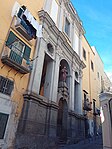Piedigrotta
Campanian geography stubsZones of Naples

Piedigrotta (Italian: [ˌpjɛdiˈɡrɔtta]; Neapolitan: Piererotta [ˌpjereˈrottə]; lit. "at the foot of the grotto") is a section of the Chiaia quarter of Naples, Italy, so-called for the presence of the Church of the Madonna of Piedigrotta near the entrance to the Crypta Neapolitana. The area was also well known for an annual festival, which gave rise to a song writing competition leading to the commercial birth of the popular Neapolitan song.
Excerpt from the Wikipedia article Piedigrotta (License: CC BY-SA 3.0, Authors, Images).Piedigrotta
Salita Piedigrotta, Naples Chiaia
Geographical coordinates (GPS) Address Nearby Places Show on map
Geographical coordinates (GPS)
| Latitude | Longitude |
|---|---|
| N 40.830555555556 ° | E 14.219722222222 ° |
Address
Salita Piedigrotta
Salita Piedigrotta
80122 Naples, Chiaia
Campania, Italy
Open on Google Maps










